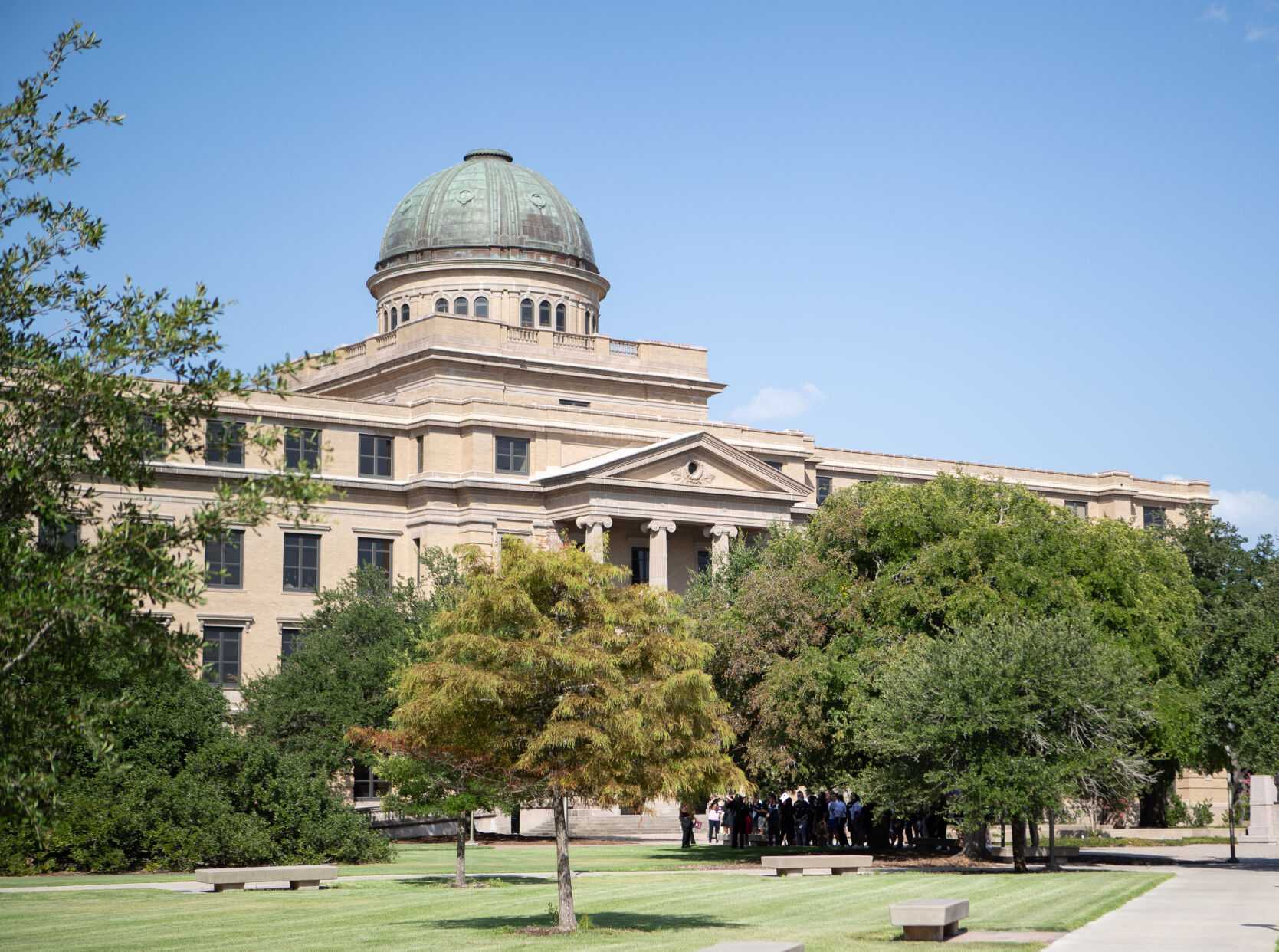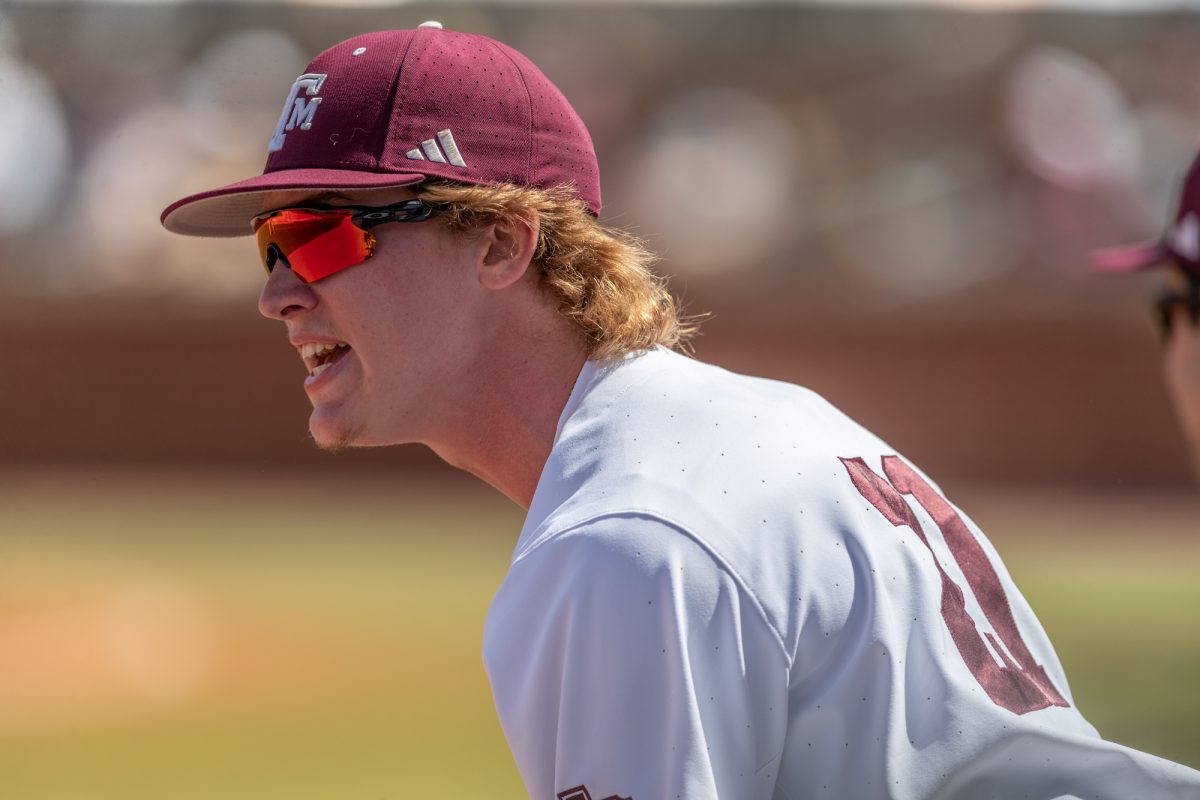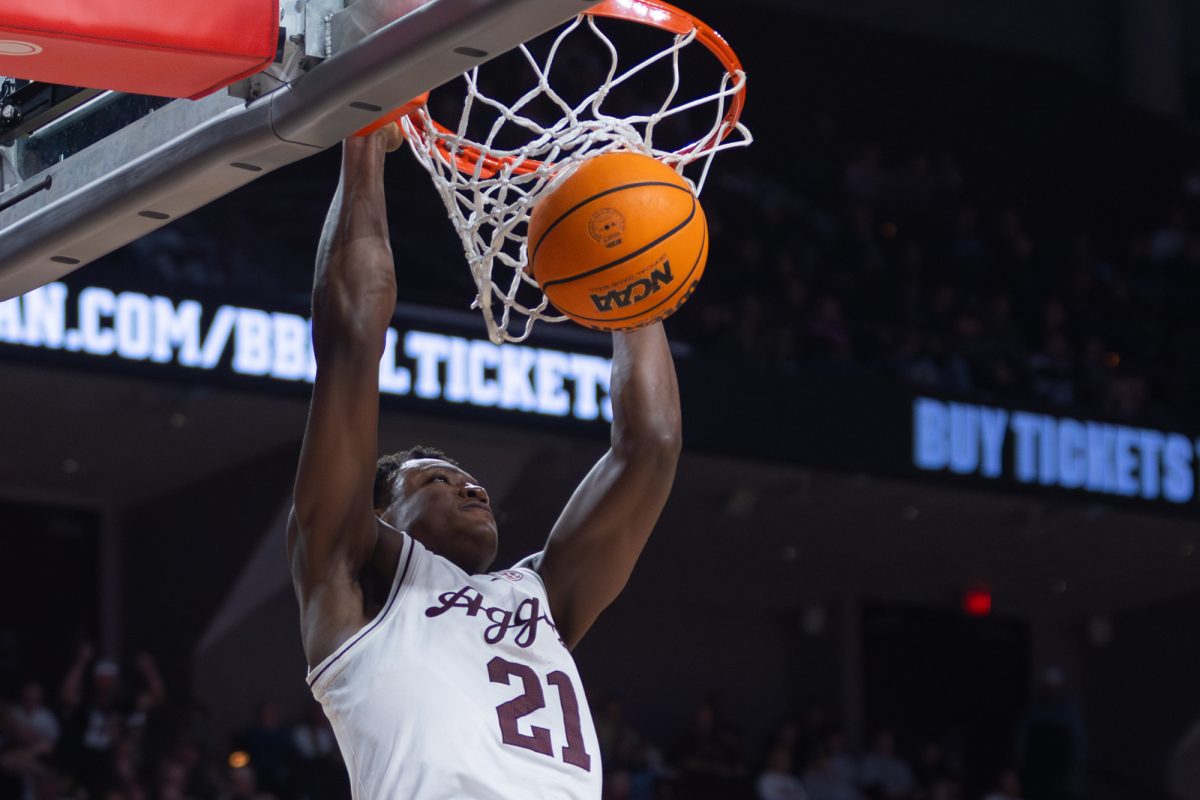Campus Voices

According to The Healthy Mind Network’s 2023 nationwide data on depression in college students, of the 96,000 college students who responded, 40.8%, or roughly 39,000 students, reported experiencing symptoms of depression.
While Texas A&M offers a variety of mental health resources including on-campus counseling services, a 24-hour helpline, the TELUS student support app and group workshops, there are new technologies under development including an Apple watch app for anxiety and a brain implant designed to address treatment-resistant depression.
Aggies were asked about the new tech approaches to coping with anxiety and depression, as well as awareness of existing campus resources.
Rice University is developing a brain implant designed for people who struggle with treatment-resistant depression, as reported in a Jan. 26 article in the Houston Chronicle. According to the National Center for Biotechnology Information, up to 30% of cases of clinical depression are classified as treatment-resistant, meaning they do not respond to prescriptions or cognitive behavioral therapy.
Communication sophomore Tyler Escue said he might consider the implant if it were a last resort.
“I personally never had depression, so I don’t know, but I think if all else fails, potentially I would be okay with it,” Escue said, “It would not be a first resort.”
Sport management freshman Taurean York said he would not approve of using a medical device implant to treat depression.
“Yeah, I don’t know about a brain implant, I don’t think I would do that,” York said. “I think it depends on who you are, but for me, I think I would pass on that.”
A&M engineering researchers are currently developing a project called mHELP, a feature for the Apple Watch that will identify anxiety, according to a recent Texas A&M Today article. The app is able to detect irregular heartbeat, which will then alert the student’s phone, leading them to an exercise that will help calm anxiety.
Accounting sophomore Alexia Garza said mHELP would be useful for students who need immediate relief.
“I like that the watch can detect all of that,” Garcia said. “I like that it can regulate your heartbeat or if you are really stressed out and on the verge of a panic attack you can take the steps necessary to avoid that.”
According to the Federal Trade Commission, many health apps may use sensitive information for their research, target users with advertisements or sell users’ information to other companies. Unlike a doctor, health apps may not be under privacy laws like HIPAA.
Finance senior Ryan Cegielski said he was open to the idea of apps that tracked health if they worked.
“I haven’t had experience with it so I wouldn’t know until it happened to me,” Cegielski said. “But I probably would, if it was something that would work.”
Isabella Diebolt, a public health senior, said even though these types of devices are selling user data, she would still use them if they improved her mental health.
“In this world today, everything I’m putting [online] is gonna be seen by someone,” Diebolt said. “If it is helping me, then it is helping me. If anything, I want people to know and see how it’s helped me in this way.”
National data estimates 40% of college students experience depression or anxiety, while 12% would be expected to report treatment-resistant depression based on research. With A&M’s 2023-24 academic enrollment of around 77,000 students, around 9,240 students would be expected to be experiencing treatment-resistant depression based on national statistics.
Diebolt noted she has had mental health struggles.
“If my antidepressants didn’t work, I definitely would consider [the implant],” Diebolt said. “Depression affects literally every thought you have, like everything you think about and it’s just a trickle effect into every aspect of your life, so if nothing else is working or really helping then I would definitely consider doing [the implant].”
In a 2020 survey, the National Library of Medicine noted that 40 to 60 people out of 100 who took antidepressants noticed an improvement in their depression symptoms within six to eight weeks.
Cole Baxter, Class of 2021, said he thinks the implant is a way for people to make money and will possibly cause people to “lose their humanity.”
“This thing is designed to treat mental health diseases — whatever they may be — but so were the pharmaceuticals,” Baxter said. “Antidepressants and stuff, if they are not completely ineffective, then they are essentially poison because they cause a lot of the psychological breaks that you see in young people.”
Common side effects of antidepressants in adolescents in a 2021 study by Baylor University Medical Center Proceedings included nausea, dizziness and insomnia, but there are some rare side effects including psychosis, hypertension and skin symptoms.
Cegielski said he has seen changes in his family who struggled with treatment-resistant depression but found alternative treatments to help them.
“I believe there are other ways to cure [mental health issues], but to be honest I do not really believe in the medicine either because I think they are just trying to get you hooked on it,” Cegielski said. “I feel like there are so many different ways, such as changing your food, because I’ve had people in my family change without medicine or doctors.”
Baxter said he would not trust technology or an implant to treat mental health issues and he predicted that since these device diagnoses are based solely on physiologic changes, it will not end up helping people.
“There are so many things that can increase your heart rate or make you jump,” Baxter said. “It doesn’t have to be anxiety, and it doesn’t have to be depression. I think that’s going to backfire badly and it’s going to feed in people’s minds that they’re messed up when they’re actually not. As technology is concerned in helping mental health, try cat videos or music.”
Escue said he thought A&M resources were helpful.
“I think they do a good job,” Escue said. “I know during freshman year we had a class focused on specific mental health.”
Diebolt said she has dealt with depression and was familiar with A&M’s Counseling & Psychological Services.
“There’s advertising everywhere,” said Diebolt. “It’s like one of the first things you learn about being a freshman at A&M.”
Students are at risk for Seasonal Affective Disorder, or SAD, which often appears in young adults and affects about 5% of adults in the United States, according to a study published by the National Institute of Mental Health. Serotonin activity is promoted by vitamin D, but a lack of sunlight during this time of year can negatively affect mood and increase symptoms of decreased energy and difficulty concentrating. Communication junior Thane Moustakas said while he does not suffer from SAD, some of those closest to him do.
“My girlfriend tends to get really depressed when it’s gloomy out,” Moustakas said.
Moustakas said his daily activities help him keep his mental health in check.
“I go to the gym every day and though that doesn’t target anything specific it really helps keep my mood up,” Moustakas said.
Public health senior Emily Korger said she has noticed a difference in her mood.
“I’m not as productive and want to stay in,” Korger said. “Having to walk, I am less inclined to do things on campus or go to class.”
Electrical engineering junior Giovani Lecky said he feels during dreary days.
“When it’s cloudy, when it’s cold, it makes me feel bad, just in general,” Lecky said. “ … I don’t want to do homework because it’s raining outside, and there’s no reason to go outside because it’s wet, and since I’m not going outside I don’t feel productive, and then I feel bad for not being productive.”
Kinesiology sophomore Isaiah Billingsley shared a similar sentiment about cloudy days.
“I don’t think I’m nearly as energized and I do coup myself up in my room,” said Billingsley, who tries to take his dog on walks and spend time with other people to cope.
Biomedical sciences senior Presley Johnston noted she has a vitamin D deficiency and has it especially hard this time of year.
“I do find that when I’m outside more I’m in a better mood, so I do genuinely try to just put myself in nature sometimes,” Johnston said. “Even if it’s just sitting on my front porch, I feel like that helps.”
Johnston said her diet and exercise routine start slipping this time of year, especially when coming back from the holidays.
“I am pretty active year-round,” Johnston said. “But now I just want to curl up in bed.”
Billingsley noted he has a “pretty good” diet.
“I eat fish, those kinds of foods that boost serotonin, pretty often,” Billingsley said.
A news article from the Mayo Clinic suggests that a light box emitting up to 10,000 Lux of light may cause a chemical change in the brain of a patient suffering from SAD and can raise mood, easing other symptoms. Sunlight lamps have gone viral on the social media platform TikTok.
While none of the Aggies interviewed said they knew of any resources on campus that could help with SAD, oceanography sophomore Anna James said she was recently gifted a light therapy lamp to boost her serotonin levels.
“I’ve never used it before though,” James said. “I’m excited to see if it will actually make a difference in my mood. I’ve been seeing it a lot recently, so I hope it works.”
Korger and Johnston both said they had heard of light box therapy and would try it.
“If it helps with that kind of stuff, then yeah, anything to get me out of bed,” Korger said. “Especially when the weather gets bad, it would be good to have something helpful, so accessible.”
General engineering freshman Mansi Bhakta said the weather does not impact her mood or productivity, but it does affect her close friends. While she had not heard of light therapy lamps, Bhakta said the idea was interesting.
“I have never seen those but I think it would be nice to wake up to the sunrise every morning,” Bhakta said. “They might even be helpful for students who have classes at 8 a.m.”
Due to record-breaking heat during the summer, crawfish season in Texas and Louisiana has seen a spike in prices, although experts predict prices will drop as the season continues.
Data from the U.S. Drought Monitor shows that 56% of the nation experienced some form of drought from June to July 2023, a crucial time in crawfish production leading to low supplies, according to a recent article in the Houston Chronicle. During that same time, 58% of Texas and 70% of the East Texas climate divisions were also experiencing drought conditions.
When crawfish farm soil is too dry, crawfish burrows can crack and dry out, leading to fewer live crawfish over the season, according to Todd Fontenot, a Louisiana State University AgCenter extension agent quoted in the article.
Todd Sink with Texas A&M’s Department of Rangeland, Wildlife and Fisheries Management told Houston’s ABC13 that he has seen a pound of live crawfish go for nearly $14 this season.
Kinesiology freshman Jose Mendoza said although he doesn’t eat much seafood, high restaurant prices would influence him to make smarter financial decisions about where to buy the delicacy.
“I personally wouldn’t go as far to spend $14,” Mendoza said. “I would probably just try to find some sort of alternative to the crawfish that is either in the same price range or cheaper.”
As someone who works for a crawfish and other seafood producer, psychology senior Alexis Skelton said she does not buy crawfish from restaurants because she leaves it up to her parents to do the crawfish boil.
“I personally never really purchase at a restaurant because my family usually does their own boils,” Skelton said. “ … I do work at H-E-B, so I know that I’ve had to deal with a lot of angry people.”
According to The Crawfish App, the H-E-B on Texas Avenue in south College Station currently charges $10 a pound for live crawfish.
Dividing the cost with friends is another strategy, Skelton said.
“I mean, if we were to have a big boil, we all just split prices so that it’s not all on one person, so it doesn’t affect us too heavily,” Skelton said.
Northpoint Crossing leasing specialist AJ Solomon was interviewed while handing out flyers in the MSC and said he is hesitant after seeing the price tag of the “mudbugs.”
“If we, you know, go and get a big group of friends and we split the bill — I mean, we’re getting five, six pounds of crawfish — you know it’s going to be like going out to a five-star restaurant,” Solomon said. “It’s definitely not making me want to go get crawfish as much as I love it.”
Although Sink predicted in the ABC13 interview that prices will likely go down at the end of February, he noted they will still be higher than last year. Geography junior Taylor Hervey said he would just have his own boil with friends.
“We could all just split the check or whatever but I probably wouldn’t get crawfish at a restaurant because they would mark up the price double or triple what it actually is,” Hervey said.
While most seafood places have a variety of dishes throughout the year, other restaurants like Cajun Kitchen rely heavily on crawfish sales to stay open in the offseason and are upcharging to $13-$15 per pound this season to survive, according to owner John Nguyen in the Houston Chronicle.
High prices might make biology junior Nickan Poshtkoohi less inclined to buy crawfish at all, he said.
“If a restaurant has it for 10 [dollars] or even higher, I would not buy the crawfish,” Poshtkoohi said, “If [there] was a restaurant with cheaper, then I would be more inclined to change restaurants. Ten is a pretty significant price jump, and I probably wouldn’t even buy crawfish at that point if it was $10 a pound.”
Your donation will support the student journalists of Texas A&M University - College Station. Your contribution will allow us to purchase equipment and cover our annual website hosting costs, in addition to paying freelance staffers for their work, travel costs for coverage and more!








